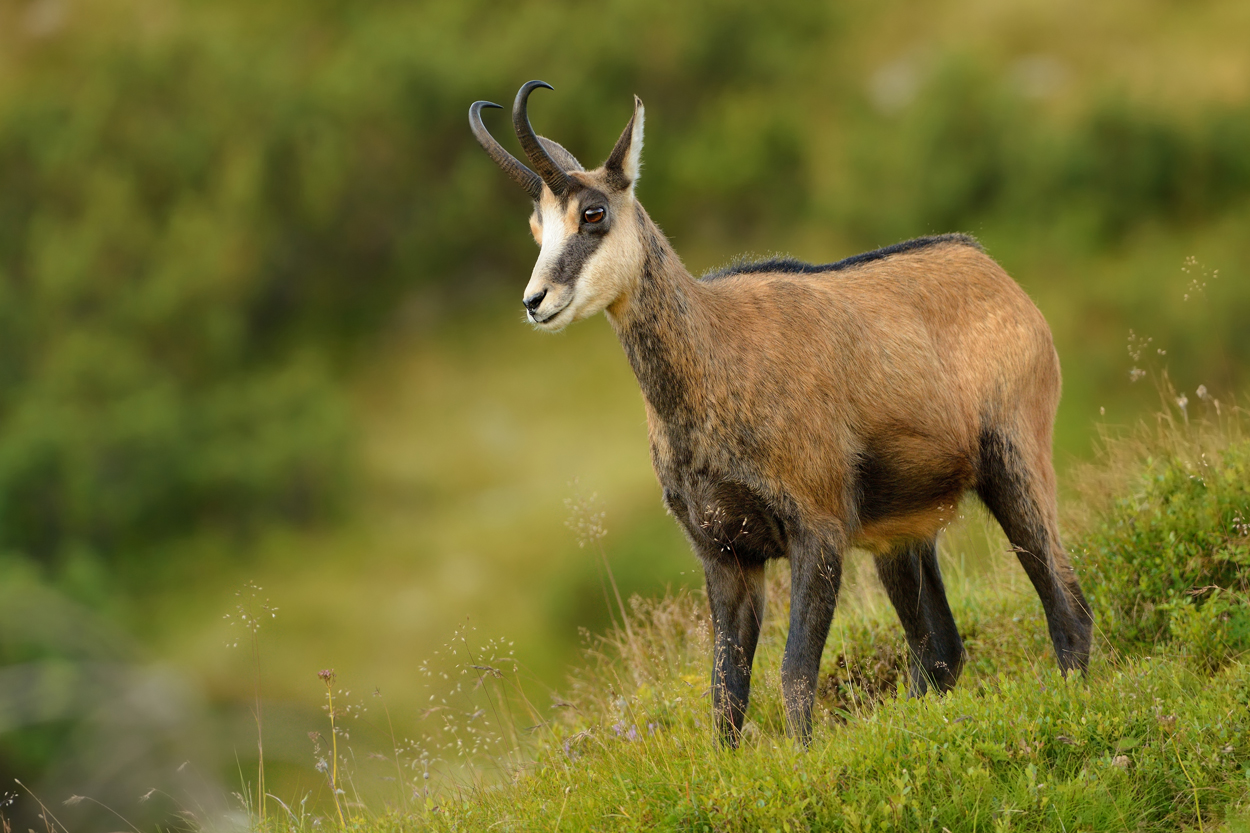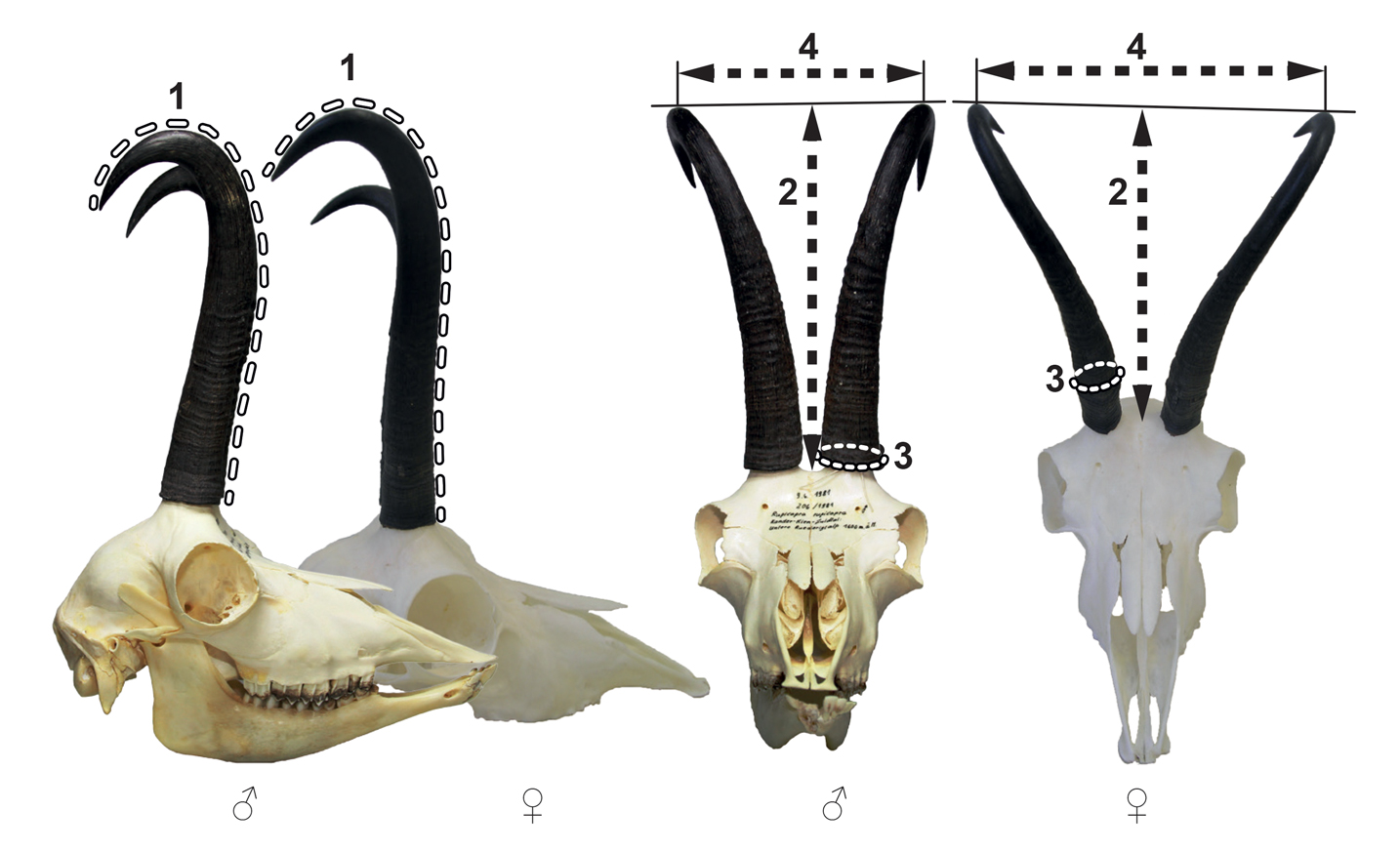Chamois
(Rupicapra rupicapra)
The Trophy
Both sexes of chamois have sleek black horns, which are curved at the top. The horns are relatively close together, however variations occur in the different phenotypes. The horns rise quickly, almost vertically, and then bend back abruptly into a hook, which goes behind, under and slightly outwards, whereby the hook formation on males is more pronounced than on females. The horns of the females usually has an angle of bend between 90 and 135°, with the tips pointing almost always backwards, while the chamois horns make a full semicircle, with the tips of the horn pointing downwards. The horns of the females have a smaller circumference over the entire length, and in cross section, they are more oval than the nearly circular cross section of the males. Exceptions may occur, i.e. there are males with horns, which are very similar to females or vice versa. The chamois horns grow quickly and early and reach about 95 percent of their length by the time the animal is about 4 years old. The horns grow as horn cones over a bony pivot. Each year the newly growing horn cone pushes the horn cone from previous years to the top. A distinct groove or ring forms at the bottom edge. After the second summer, growth of the horn’s length slows down and after the 5th summer is only about 1 mm each side add per annum. Quick growth of horns in younger animals between 2 and 4 years can also lead to the formation of jewellery rings. Barren goats can see an annual horn growth of up to 4 or 5 mm, even if they are older. For chamois older than 4 to 5 years, the circumference of the horns in the horn base decreases compared to the young chamois. Consequently, the largest horn circumference in mature male and female chamois is never found at the base, but just above the horn. With horns from mature males, an accumulation of resins on the lower part of the horn surface is often revealed, the so-called horn deposit, which can be several millimetres thick.
Male and female horns are measured with the same formula.
Trophy Points Required
|
Phenotype |
Bronze |
Silver |
Gold |
|
Pyrennean Chamois (male) |
87 |
92 |
97 |
|
Pyrennean Chamois (female) |
83 |
88 |
93 |
|
Cantabrian Chamois (male) |
78 |
81.5 |
85 |
|
Cantabrian Chamois (female) |
74 |
77.5 |
81 |
|
Apennine Chamois |
|
|
|
|
Alpine Chamois (male) |
100 |
105 |
110 |
|
Alpine Chamois (female) |
95 |
100 |
105 |
|
Chartreuse Chamois (male) |
100 |
105 |
110 |
|
Chartreuse Chamois (female) |
95 |
100 |
105 |
|
Tatra Chamois |
|
|
|
|
Balkan Chamois (male) |
100 |
105 |
110 |
|
Balkan Chamois (female) |
95 |
100 |
105 |
|
Carpathian Chamois (male) |
100 |
105 |
110 |
|
Carpathian Chamois (female) |
95 |
100 |
105 |
|
Caucasus Chamois (male) |
87 |
92 |
97 |
|
Caucasus Chamois (female) |
83 |
88 |
93 |
|
Anatolian Chamois (male) |
87 |
92 |
97 |
|
Anatolian Chamois (female) |
80 |
82 |
83 |
Copyright © 2023 CIC UKTEB. All content, imagery and rights belong to the International Council for Game & Wildlife Conservation United Kingdom Trophy Evaluation Board (CIC UKTEB)


